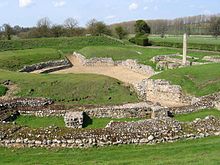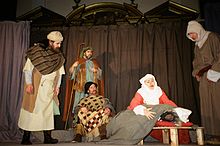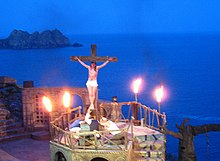Theatre of the United Kingdom

Theatre of United Kingdom plays an important part in
Beginnings

Theatre was introduced from
Medieval theatre: 500–1500

The medieval
There are four complete or nearly complete extant English biblical collections of plays from the late
These biblical plays differ widely in content. Most contain episodes such as the Fall of Lucifer, the Creation and Fall of Man, Cain and Abel, Noah and the Flood, Abraham and Isaac, the Nativity, the Raising of Lazarus, the Passion, and the Resurrection. Other pageants included the story of Moses, the Procession of the Prophets, Christ's Baptism, the Temptation in the Wilderness, and the Assumption and Coronation of the Virgin. In given cycles, the plays came to be sponsored by the newly emerging Medieval
Having grown out of the religiously based mystery plays of the Middle Ages, the morality play is a genre of Medieval and early Tudor theatrical entertainment, which represented a shift towards a more secular base for European theatre. In their own time, these plays were known as "interludes", a broader term given to dramas with or without a moral theme.[3] Morality plays are a type of allegory in which the protagonist is met by personifications of various moral attributes who try to prompt him to choose a Godly life over one of evil. The plays were most popular in Europe during the 15th and 16th centuries.
Renaissance theatre: 1500–1660

The reign of
The English playwrights were intrigued by the Italian model as a conspicuous community of Italian actors had settled in London. The linguist and lexicographer
George Chapman (c. 1559–1634) was a successful playwright who produced comedies (his collaboration on Eastward Hoe led to his brief imprisonment in 1605 as it offended the King with its anti-Scottish sentiment), tragedies (most notably Bussy D'Ambois) and court masques (The Memorable Masque of the Middle Temple and Lincoln's Inn).
Drama in
Restoration theatre: 1660 to 1710
During the
Although documented history of
Theatre began to spread from the United Kingdom to the expanding British Empire. Farquhar's The Recruiting Officer was the first play to be staged in New York City on December 6, 1732.[11] It was also the first play to be staged in the Colony of New South Wales,[12] which is now Australia.

The age of Augustan drama was brought to an end by the censorship established by the Licensing Act 1737. After 1737, authors with strong political or philosophical points to make would no longer turn to the stage as their first hope of making a living, and novels began to have dramatic structures involving only normal human beings, as the stage was closed off for serious authors. Prior to the Licensing Act 1737, theatre was the first choice for most wits. After it, the novel was.
18th-century
In the 18th century, the highbrow and provocative Restoration comedy lost favour, to be replaced by sentimental comedy, domestic Bourgeois tragedy such as George Lillo's The London Merchant (1731), and by an overwhelming interest in Italian opera. Popular entertainment became more important in this period than ever before, with fair-booth burlesque and mixed forms that are the ancestors of the English music hall. These forms flourished at the expense of legitimate English drama, which went into a long period of decline. By the early 19th century it was no longer represented by stage plays at all, but by the closet drama, plays written to be privately read in a "closet" (a small domestic room).
Romanticism: 1798–1836
Percy Bysshe Shelley and Lord Byron were the most important literary dramatists of their time (although Shelley's plays were not performed until later in the century). Shakespeare was enormously popular, and began to be performed with texts closer to the original, as the drastic rewriting of 17th and 18th century performing versions for the theatre (as opposed to his plays in book form, which were also widely read) was gradually removed over the first half of the century.

Melodramas, light comedies, operas, Shakespeare and classic English drama,
Scotland
Scottish "national drama" emerged in the early 1800s, as plays with specifically Scottish themes began to dominate the Scottish stage. The existing repertoire of Scottish-themed plays included John Home's Douglas (1756) and Ramsay's The Gentle Shepherd (1725), with the last two being the most popular plays among amateur groups.[13] Douglas elicited the famous "Whaur's Yer Wullie Shakespeare Noo?" jeer from a member of one of its early audiences, and was also the subject of a number of pamphlets for and against it. It also arguably led to James MacPherson's Ossian cycle.[14][15] Home was hounded by the church authorities for Douglas. It may have been this persecution which drove Home to write for the London stage, in addition to Douglas' success there, and stopped him from founding the new Scottish national theatre that some had hoped he would.[14] Walter Scott was keenly interested in drama, becoming a shareholder in the Theatre Royal, Edinburgh.[16] Baillie's Highland themed The Family Legend was first produced in Edinburgh in 1810 with the help of Scott, as part of a deliberate attempt to stimulate a national Scottish drama.[17] Scott also wrote five plays, of which Hallidon Hill (1822) and MacDuff's Cross (1822), were patriotic Scottish histories.[16] Adaptations of the Waverley novels, largely first performed in minor theatres, rather than the larger Patent theatres, included The Lady in the Lake (1817), The Heart of Midlothian (1819), and Rob Roy, which underwent over 1,000 performances in Scotland in this period. Also adapted for the stage were Guy Mannering, The Bride of Lammermoor and The Abbot. These highly popular plays saw the social range and size of the audience for theatre expand and helped shape theatre going practices in Scotland for the rest of the century.[13]
Victorian era: 1837–1901
In 1847, a critic using the pseudonym Dramaticus published a pamphlet[18] describing the parlous state of British theatre. Production of serious plays was restricted to the patent theatres, and new plays were subjected to censorship by the Lord Chamberlain's Office. At the same time, there was a burgeoning theatre sector featuring a diet of low melodrama and musical burlesque; but critics described British theatre as driven by commercialism and a 'star' system. Kotzebue's plays were translated into English and Thomas Holcroft's A Tale of Mystery was the first of many English melodramas. Pierce Egan, Douglas William Jerrold, Edward Fitzball, James Roland MacLaren and John Baldwin Buckstone initiated a trend towards more contemporary and rural stories in preference to the usual historical or fantastical melodramas. James Sheridan Knowles and Edward Bulwer-Lytton established a "gentlemanly" drama that began to re-establish the former prestige of the theatre with the aristocracy.[19]
For much of the first half of the 19th century, drama in London and provincial theatres was restricted by a licensing system to the Patent theatre companies, and all other theatres could perform only musical entertainments (although magistrates had powers to license occasional dramatic performances). By the early 19th century, however,
James Planché was a prolific playwright. He revolutionised stage productions of Shakespeare and the classics by introducing the use of historically appropriate costume design, working with antiquarians to establish what was known about period dress.[21]
Dion Boucicault (1820–90) made the latest scientific inventions important elements in his plots and exerted considerable influence on theatrical production. His first big success, London Assurance (1841) was a comedy in the style of Sheridan, but he wrote in various styles, including melodrama. T. W. Robertson wrote popular domestic comedies and introduced a more naturalistic style of acting and stagecraft to the British stage in the 1860s.
A change came in the late 19th century with the plays on the London stage by the Irishmen
Producer
20th-century
At the end of the century, Edwardian musical comedy came to dominate the musical stage.[27]
Irish playwrights
In the 1920s and later
Saunders Lewis (1893–1985), writer in Welsh, was above all a dramatist. His earliest published play was Blodeuwedd (The woman of flowers) (1923–25, revised 1948). Other notable plays include Buchedd Garmon (The life of Germanus) (radio play, 1936) and several others after the war.
After 1945
The
The
An important cultural movement in the British theatre that developed in the late 1950s and early 1960s was
Again in the 1950s, the
Beyond the Fringe was a comedy stage revue written and performed by Peter Cook, Dudley Moore, Alan Bennett, and Jonathan Miller. It played in London's West End and then on New York's Broadway in the early 1960s, and is widely regarded as seminal to the rise of satire in 1960s Britain.
The
The Theatres Act 1968 abolished the system of censorship of the stage that had existed in Great Britain since 1737. The new freedoms of the London stage were tested by Howard Brenton's The Romans in Britain, first staged at the National Theatre during 1980, and subsequently the focus of an unsuccessful private prosecution in 1982.
The height of Alan Ayckbourn's commercial success included Absurd Person Singular (1975), The Norman Conquests trilogy (1973), Bedroom Farce (1975) and Just Between Ourselves (1976), all plays that focused heavily on marriage in the British middle classes. Throughout his writing career, all but four of his plays were premièred at the Stephen Joseph Theatre in Scarborough in its three different locations.[35] The Stephen Joseph Theatre was the first theatre in the round in Britain.
Other playwrights whose careers began later in the century are: Caryl Churchill (Top Girls, 1982), Michael Frayn (1933-) playwright and novelist, David Hare (1947- ), David Edgar (1948- ). Dennis Potter's most distinctive dramatic work was produced for television.
Translations by Brian Friel was first performed at the Guildhall, Derry, Northern Ireland, in 1980. An Irish-language version of the play has been produced.[36] The play has also been translated into Welsh by Elan Closs Stephens. The Welsh version has visited a number of venues in Wales and was first published by Gwasg Carreg Gwalch, under its Welsh title Torri Gair ("Breaking the Word"), in 1982. It is "a play about language and only about language", but it deals with a wide range of issues, stretching from language and communication to Irish history and cultural imperialism. Friel responds strongly to both political and language questions in modern-day Northern Ireland.
In 1970, American actor and director Sam Wanamaker founded the Shakespeare Globe Trust and the International Shakespeare Globe Centre, with the objective of building a faithful recreation of Shakespeare's Globe close to its original location at Bankside, Southwark. Shakespeare's Globe opened to the public in 1997. Performances are engineered to duplicate the original environment of Shakespeare's Globe; there are no spotlights, plays are staged during daylight hours and in the evenings (with the help of interior floodlights), there are no microphones, speakers or amplification.
Radio drama
During the 1950s and 1960s, many major British playwrights either effectively began their careers with the
Other notable radio dramatists included Brendan Behan and novelist Angela Carter. Novelist Susan Hill also wrote for BBC radio, from the early 1970s.[40] Irish playwright Brendan Behan, author of The Quare Fellow (1954), was commissioned by the BBC to write a radio play The Big House (1956); prior to this he had written two plays Moving Out and A Garden Party for Irish radio.[41]
Among the most famous works created for radio are
Samuel Beckett wrote a number of short radio plays in the 1950s and 1960s, and later for television. Beckett's radio play Embers was first broadcast on the BBC Third Programme on 24 June 1959, and won the RAI prize at the Prix Italia awards later that year.[44]
National theatres
From the 1840s there was a demand to commemorate serious theatre, with the "Shakespeare Committee" purchasing the playwright's birthplace for the nation demonstrating a recognition of the importance of 'serious drama'. The following year saw more pamphlets on a demand for a National Theatre from London publisher, Effingham William Wilson.
The theatrical landscape has since been reconfigured, moving from a single national theatre at the end of the 20th century to four as a result of the devolution of cultural policy.
West End theatre
The West End of London has a large number of theatres, particularly centred around Shaftesbury Avenue.
West End theatre is a popular term for mainstream professional theatre staged in the large theatres of London's "Theatreland".[50] Along with New York's Broadway theatre, West End theatre is usually considered to represent the highest level of commercial theatre in the English-speaking world. Seeing a West End show is a common tourist activity in London.[50]

A prolific composer of
See also
- Theatre of Scotland
- Theatre of Wales
- Theatre of Ireland
- List of theatres in the United Kingdom
- Laurence Olivier Awards — presented annually by the Society of London Theatre to recognise excellence in professional theatre in London.
References
- ISBN 0853435499.
- ISBN 9780300106367.
- ^ Richardson and Johnston (1991, 97-98).
- ^ Kyd, Thomas; Schick, Josef (1898). The Spanish tragedy, a play. University of Michigan. London, J.M. Dent and co.
- ISBN 9780333666647.
- ^ The first ever known full production of the text was mounted by Biggar Theatre Workshop in September 1997 under the direction of Ann Matheson. See Theatre in Scots p.4
- ^ Association of Scottish Literary Studies Archived 2012-03-02 at the Wayback Machine, Edwin Morgan, ScotLit 20, Spring 1999
- ISBN 0708313833.
- ISBN 0091613612.
- ISBN 9780140299403.
- ^ Hornblow, Arthur, A History of the Theater in America from Its Beginnings to the Present Time, J. B. Lippincott, 1919, Volume 1, p. 42
- ISBN 978-1-85459-317-7
- ^ ISBN 0748624813, p. 231.
- ^ a b Keay, J. & Keay, J. (1994) Collins Encyclopaedia of Scotland. London. HarperCollins.
- ^ Whaur’s yer Wullie noo?[permanent dead link]
- ^ ISBN 0748624813, pp. 185-6.
- ISBN 0754665690, p. 43.
- ^ Dramaticus The stage as it is (1847)
- ^ Brockett and Hildy (2003, 297–298).
- ^ Theatre and the State in Twentieth-Century Ireland: Cultivating the People, Lionel Pilkington: Review by: Christopher Murray in Irish University Review, Vol. 32, No. 2 (Autumn - Winter, 2002), pp. 380-384
- ^ Reinhardt, The Costume Designs of James Robinson Planché, p526–7
- ^ Crowther, Andrew (28 June 1997). "The Carpet Quarrel Explained". The Gilbert and Sullivan Archive. Retrieved 6 November 2007.[dead link]
- ^ Davis, Peter G (21 January 2002). "Smooth Sailing". Retrieved 6 November 2007.
- ^ "The Savoy Theatre", The Times, 3 October 1881
- ^ Description of lightbulb experiment in The Times, 28 December 1881
- ^ Brockett and Hildy (2003, 326–327).
- In Town (1892). See, e.g., Charlton, Fraser. "What are EdMusComs?"FrasrWeb 2007, accessed May 12, 2011
- ^ The Oxford Companion to English Literature. (1996), p. 781.
- ^ "English literature." Encyclopædia Britannica. Encyclopædia Britannica Online Academic Edition. Encyclopædia Britannica Inc., 2012. Web. 15 Nov. 2012. <http://www.britannica.com/EBchecked/topic/188217/English-literature>.
- ^ Kemp, Robert, More that is Fresh in Drama, Edinburgh Evening News, 14 August 1948
- ^ Walker, John. (1992) "Kitchen Sink School". Glossary of Art, Architecture & Design since 1945, 3rd. ed. Retrieved 29 August 2012.
- ^ The Oxford Companion to English Literature, ed. Margaret Drabble (Oxford: Oxford University Press,1996), p.80.
- ^ The Oxford Companion to English Literature, p.80.
- ^ Canadian Encyclopedia - Stratford Festival
- ^ Biography on the official Alan Ayckbourn website Archived 2008-08-07 at the Wayback Machine accessed 5 January 2009
- ^ PlayographyIreland - Aistriúcháin. Irishplayography.com (1995-11-13). Retrieved on 2013-07-29.
- ^ Caryl Churchill - Playwright. Doollee.com. Retrieved on 2013-07-29.
- ^ a b Tim Crook, "International radio drama"
- ^ "John Mortimer Radio Plays"; John Mortimer Biography (1923-2009)
- ^ RADIO DRAMA,APPLES,EKEGUSII,POTATOES,EARLY MUSIC,kiss off,misfit,former url http://web.ukonline.co.uk/suttonelms. Suttonelms.org.uk. Retrieved on 2013-07-29.
- ^ The Columbia encyclopedia of modern drama, by Gabrielle H. Cody; "Brendan Behan" - RTÉ Archives [1]
- ^ J. C. Trewin, "Critic on the Hearth." Listener [London, England] 5 Aug. 1954: 224.
- ^ British Theatrelog: Volume 1, Issue 8. Google Books: TQ Publications. 1978. p. 21.
- ^ Prix Italia "PAST EDITIONS — WINNERS 1949 - 2007" Archived 2012-03-03 at the Wayback Machine
- ^ Effingham William Wilson A House for Shakespeare. A proposition for the consideration of the Nation and a Second and Concluding Paper (1848)
- ISBN 0-389-20483-8.
- ^ Findlater, Richard The Winding Road to King's Reach (1977), also in Callow. Retrieved 1 July 2008.
- ^ Dickson, Andrew (2 August 2011). "Edinburgh festival 2011: where National Theatres meet". The Guardian. Retrieved 4 November 2012.
- ^ Gardner, Lyn (1 September 2011). "Has Welsh theatre found its voice?". The Guardian. Retrieved 4 November 2012.
- ^ ISBN 0-521-43437-8.
- ^ Sondheim and Lloyd-Webber: the new musical The New York Times.. referred to Andrew Lloyd Webber as "the most commercially successful composer in history"
- ^ BBC - Radio 2 - Elaine Paige BBC Radio
